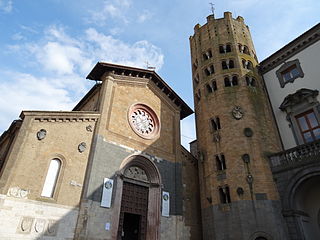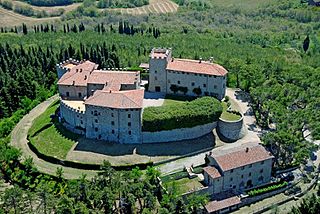
Palazzo dei Papi is a palace in Viterbo, northern Latium, Italy. It is one of the most important monuments in the city, situated alongside the Duomo di Viterbo. The Papal Curia was removed to Viterbo in 1257 by Alexander IV, due to the hostility of the Roman commune and constant urban violence: the former bishop's palace of Viterbo was enlarged to provide the Popes with an adequate residence. The construction, commissioned by the Capitano del popolo Raniero Gatti, provided a great audience hall communicating with a loggia raised on a barrel vault above the city street. It was completed probably around 1266.

Orvieto Cathedral is a large 14th-century Roman Catholic cathedral dedicated to the Assumption of the Virgin Mary and situated in the town of Orvieto in Umbria, central Italy. Formerly the episcopal seat of the Diocese of Todi, it has been since 1986 that of the Diocese of Orvieto-Todi.

Castel Giorgio is a comune (municipality) in the Province of Terni in the Italian region Umbria, located about 60 km southwest of Perugia and about 60 km northwest of Terni on the Alfine Highland, facing the Lake Bolsena.

Sambuca di Sicilia is a comune (municipality) in the Province of Agrigento in the Italian region Sicily, located about 68 kilometres (42 mi) southwest of Palermo and about 89 kilometres (55 mi) northwest of Agrigento.
Carlo Gualterio was an Italian Roman Catholic cardinal.

The Pozzo di San Patrizio is a historic well in Orvieto, Umbria, central Italy. It was built by architect-engineer Antonio da Sangallo the Younger of Florence, between 1527 and 1537, at the behest of Pope Clement VII who had taken refuge at Orvieto during the sack of Rome in 1527 by the Holy Roman Emperor Charles V, and feared that the city's water supply would be insufficient in the event of a siege. The well was completed in 1537 during the papacy of Pope Paul III.
Filippo Antonio Gualterio was made a papal nuncio to France (1700–1706) and a cardinal of the Roman Catholic Church from 1706.

Orvieto, Umbria, Italy, was the refuge of five popes during the 13th century: Urban IV (1261–1264), Gregory X (1271–1276), Martin IV (1281–1285), Nicholas IV (1288–1292) and Boniface VIII (1294–1303). During this time, the popes took up residence in the Papal Palace of Orvieto, which was adjacent to the Orvieto Cathedral and expanded onto the bishop's residence. None of these popes died in Orvieto, and thus no papal elections took place in there, nor are there any papal tombs.

San Domenico is a church in Orvieto, Umbria, central Italy.

Antonio del Massaro da Viterbo, or Antonio da Viterbo, nicknamed il Pastura was an Italian painter.
Saint Pietro Parenzo was a mayor of the Italian Comune of Orvieto during the 12th century. He was assassinated in 1199 by the adherents of Catharism and became honored as a saint and wonderworker after his death. He is the patron saint of the city of Orvieto.

Chiesa di Sant'Andrea is a church on the Piazza della Repubblica in Orvieto, Umbria, central Italy. It dates to the 12th century and is noted for its distinctive decagonal bell tower.

Palazzo dei Consoli is a medieval building in Gubbio, Umbria, central Italy.

Chiesa di San Francesco is a church in Orvieto, Umbria, Italy. It was consecrated in 1266. It belongs to the Roman Catholic Diocese of Orvieto-Todi.

Chiesa di San Giovenale is a church in Orvieto, Umbria, Italy. Initially constructed in 1004, it contains frescos and artefacts from the 12th and 13th centuries. It belongs to the Roman Catholic Diocese of Orvieto-Todi.
Cassa di Risparmio di Orvieto S.p.A. is an Italian bank based in Orvieto, in the Province of Terni, Umbria.

Castello di Montegiove was established in the 13th century in Umbria, Italy. It lies at 627 meters above sea-level, on the border between the old city states of Orvieto and Perugia. The castle continues to operate privately as a family farm and tourist site.















